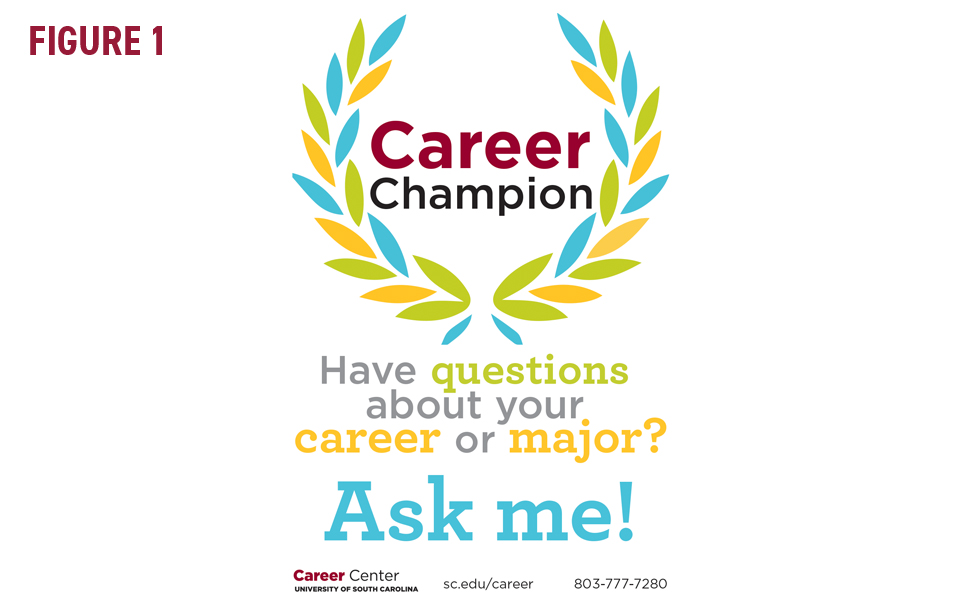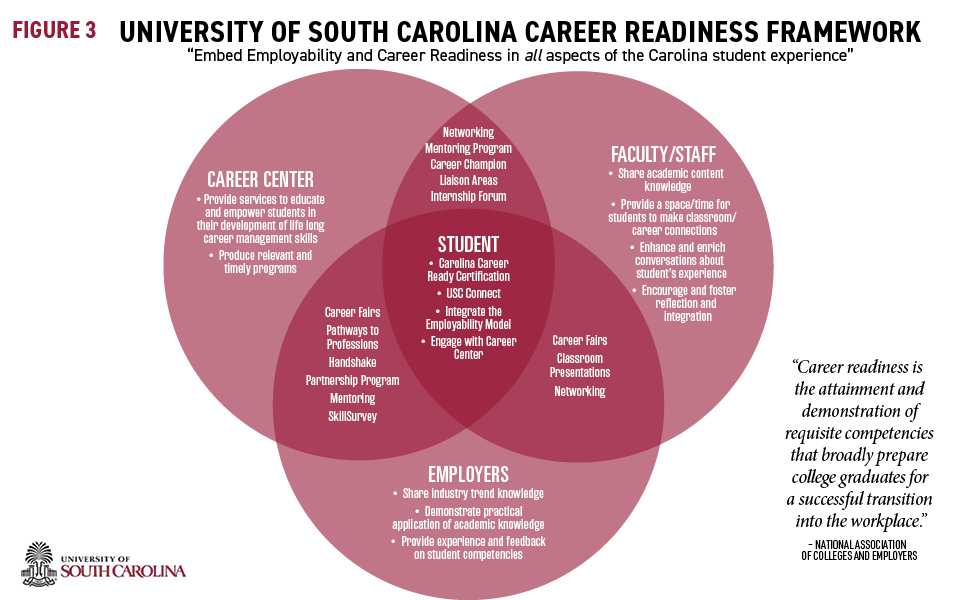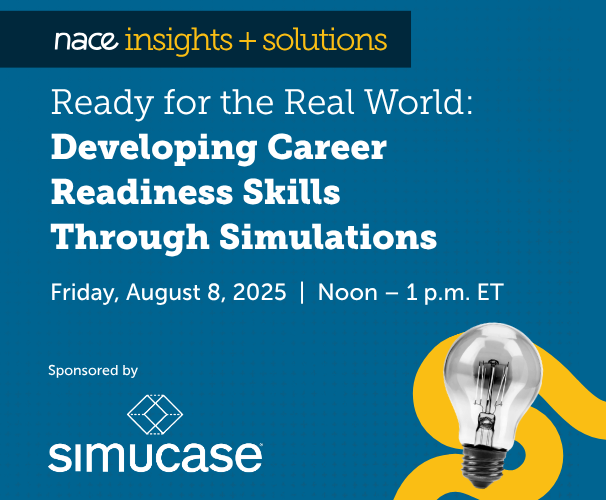NACE Journal, August 2019
What if we could change the culture on campus so that career readiness and employability is everyone’s responsibility? The University of South Carolina (USC) career center is taking steps toward making that change a reality.
For me, the idea of involving the entire campus began when I read an article titled “Scaling Career Services,” which identified three dimensions of scalability as: “1. Greater impact within constraints: achieving far greater output, outcomes, and improved performance with the same or less staff time and resources. 2. Retained quality: Operating more efficiently and effectively without losing quality. 3. Anytime and without us: many customers are getting served, even in the middle of the night when none of us are working.”1
Scalability is becoming more important in higher education, and specifically so in career services, where we are scrutinized for our ability to prepare graduates who are fully ready for the world of work. However, is it realistic to think that every student will come to the career center to receive assistance or to participate in our events and programs? Unfortunately, we know that not every student will participate, nor do we realistically have the capacity to serve them. So, how can we scale our services and serve our students with our existing resources, while retaining our quality and serving our students when and wherever they need it? The answer for USC was the career champion program.
In August of 2017, career center staff set out to create a “train the trainer” program that would allow us to serve as knowledge disseminators on the campus, to provide faculty and staff with key information and guidance about career readiness, career development, and employability, turning them into “career champions.”
This idea arose from personal experience: In my prior roles in higher education outside of the career center, students that I advised, supervised, or just got to know would often ask me for career advice, resume guidance, or support in career decision making. I always referred them to the career center, but that did not stop them from asking me. Why? It should come as no surprise that students are going to be consulting with many different people about their career path. Often, they go to the person they trust and have established rapport with and who knows them. For students, the question is why go to the career center—and have to build a relationship from scratch—when they already have someone they can tap for help?
Moreover, results of a 2017 Gallup/Strada survey back up the importance of offerings like the career champion program. The survey found that four in 10 students have never used their schools’ career services resources.2 However, 46 percent of participating students reported that they speak often or very often with faculty or staff at their school about their career options. In addition, those who do talk with faculty or staff reported greater confidence about their skills and knowledge to enter the work force than those who do not. This further supports the idea of educating and empowering our faculty and staff colleagues so they feel as equipped as possible to engage in career conversations with their students.
Gathering Ideas
We decided on three overarching goals that guided us in moving forward with the career champion program:
- To empower and education faculty/staff to gain skills/tools to enhance the impact of their career planning conversations with students;
- To develop an opportunity for service extension/scalability; and
- To deliver consistent messaging to students regarding employability.
In developing the program, we looked at models on campus. The USC campus already had some niche training programs in existence, including the safe zone training and green zone training programs, which are focused on educating the campus community on certain student populations and providing best practices for how to support these students. These trainings are a couple of hours in length and provide handouts and a decal to recognize those who completed the program. This was exactly what we were looking to do with our training in terms of format and duration; we also liked the idea of a decal to recognize those who have completed these types of trainings and decided to adopt it for our program. (See Figure 1.) The decal serves three main purposes: 1) It tells students that the person has gone through training and is ready to talk with them about career development; 2) it provides recognition to those that have completed the training; and 3) it is an opportunity for branding and marketing the career champion program.
In addition, we considered our professional development workshops, which are available through the campus human resources office. These workshops are already successful on our campus for faculty and staff, and we integrated several aspects into the career champion training, including the creation of a workbook to go along with the presentation. This workbook provides reflection points throughout the training and includes such questions as “What do you currently know about employability?” and “In what ways could you discuss work values with a student?” The workbook makes the training more personal and interactive throughout.
Content
The next step was to consider not only what we wanted participants to learn by attending the training, but also what we wanted them to do as a result.
The career center has adopted an employability model that we adapted from the career edge model developed by Lorraine Dacre Pool and Peter Sewell.3 This laid the foundation for our content. (See Figure 2.) In addition, because some potential participants may never have been to the career center or are not familiar with the office, we felt it was important to provide a brief overview of services. Overall, we walked a fine line between giving a commercial for our office and providing tangible resources that participants could use.
The following learning outcomes created the building blocks for the career champion program:
- Participants will gain a basic knowledge of career development theory and the career decision-making process;
- Participants will learn how to assist students with goal setting in relation to their career development;
- Participants will gain a foundation of basic helping skills to best assist students with career planning;
- Participants will learn how to make an effective referral to the career center; and
- Participants will learn the professional and ethical guidelines as outlined through NACE.
After putting everything together, taking into consideration our employability model and our center’s brand (Decide it. Experience it. Live it.), we decided to include the following pieces in the training:
- Overview of the career center: This is a brief introduction to expose participants to all facets of the office. We also wanted to provide an opportunity to highlight that we are more than just the “resume place.”
- USC’s employability model: We review the employability model, which prompts participants to reflect on “What can I do to help students in these areas?”
- Career development theories and the career decision-making process: To provide context around helping students with career development, we exposed participants to career development theory. For this part of the training, we focused on Holland’s code, Super’s self-concept, Kolb’s experiential learning theory, and Krumboltz’s happenstance theory. We bring these theories to life by providing participants with the worksheets we use with students so they can see the theory in action and in turn use the activities with their students.
Career decision making is also a large part of this section. We provide a framework in the format of “Who am I?,” “What’s out there?,” “How do I fit?,” and “What’s my plan?” and encourage participants to reflect on what they can do to help a student through the decision-making process. This is also a prime opportunity to help students set SMART goals and discuss the need to be resilient, flexible, and adaptable as their plans may change. - Experiential education: In this section, we go over the basics of experiential education, including what it is, why it is important, different opportunities available for students, and how to help students find opportunities.
- Professional life skills: Faculty and staff may get lots of questions from students on resumes, cover letters, interviewing, networking, and graduate school. We felt it important to provide some foundational information on how to work with students through these different conversations and provide helpful resources.
- The helping relationship: As we cannot assume that everyone comes from a counseling or higher education program where they received basic helping skills, we provide guidance on how to be an effective helper and go over the difference between counseling and helping. After this section, we tie everything together and provide case studies for participants to work through as if they were helping a student with different major-/career-related issues.
- Professional and ethical guidelines: We felt it was our due diligence to go over ethics as it would apply to faculty/staff assisting students. The NACE Principles for Ethical Professional Practice are covered and explained. In addition, we also remind everyone about FERPA, especially in relation to an employer seeking student information for positions.
- Making an effective referral to the career center: Our campus has a variety of ways that faculty/staff can refer students to our office, which we highlight in the training. In addition, the message on referral is that participants can feel free to use everything that was covered in the training and if their student is not making progress, a referral is a good next step.
- Additional campus resources: Lastly, we highlight all the other resources on our campus that may be relevant to working with students through major and career challenges.
Gaining Momentum
To test the waters on our campus and get initial buy-in, we invited colleagues that knew us and were familiar with the career center for a pilot training. This was a low-risk way to get feedback and practice the delivery of the training. The insights we received from our colleagues during this step were critical to how we moved forward. What the pilot group participants shared was they wanted more information on our actual programs and services, wanted more detail on referring students, more hands-on activities, more takeaway resources, and, possibly, a virtual option. We used all their insights to make appropriate changes before the first official training.
We opted for two trainings in the fall, two in the spring, and one over the summer. The date and time selection was done intentionally based on the academic calendar. In addition to fliers, we sent emails out to campus partners and academic departments, and made announcements at academic department chair meetings and at our overall student affairs meeting.
The next piece was marketing the training. This was a difficult step as we had to get faculty/staff interested in something that was brand new and had no existing reputation or credibility. The first marketing piece was a postcard flier; it listed training dates and the registration link and highlighted that participants would learn how to best help their students with career decision making. We distributed this to various campus partners, sent email invitations, and announced the training at various department meets. For our spring training, we mailed a hard copy flyer to faculty members, added information about the training to our website, and announced it in the student affairs division’s newsletter and at various meetings. This is still a work in progress, but we believe that word of mouth will push the program forward as faculty begin to hear about it—and its value—from fellow faculty members.
Assessing the Program
In creating this program, assessment data were at the forefront of our minds. How could we prove the program’s impact? We decided to create two post assessments. The first assessment surveys participants before they leave the training. This assessment focuses on the learning outcomes, overall satisfaction with the program, recommendations for how to improve the program, and suggestions for additional topics to cover.
The second assessment is administered electronically six months post training. This assessment gauges if and how the training has helped participants in their work with students. In addition, it asks participants to identify what was most helpful in the training, what topics they would like to learn more about, if they would be interested in additional training, and if they would be interested in joining a Blackboard community for career champions.
Since the inception of the program in fall 2017, we have completed 12 trainings and trained 203 career champions. Results of our immediate and follow-up assessments are presented here.
Immediate Assessment:
- 98 percent of participants strongly agreed/agreed that they are more knowledgeable about the career decision-making process as a result of career champion training;
- 95 percent strongly agreed/agreed they are more knowledgeable of the career development theory as a result of the training;
- 94 percent strongly agreed/agreed that they feel more equipped to assist students with goal setting in relation to their career development a result of the training;
- 94 percent strongly agreed/agreed that they feel more equipped to use helping skills to best assist students in the career decision-making process;
- 93 percent strongly agreed/agreed that they understand the ethical guidelines regarding candidate referrals, a student reneging on a job offer, and serving as a reference; and
- 96 percent strongly agreed/agreed that they know how to make an effective referral to the career center after completing the training.
Six-Month Assessment:
- 75 percent reported that the training and materials have been very helpful/helpful in their work with students, while 21 percent said they have been somewhat helpful;4
- 98 percent reported that they would be interested in participating in additional training around career topics if offered by the career center; and
- 95 percent reported that they would be interested in joining a Blackboard community for career champions to have access to electronic resources, discussions, and information.
As part of the six-month assessment, participants were also asked to identify what topics they would like to learn more about. The topics that were most mentioned in the survey were core competencies, job-search skills and trends, and creating effective experiential education opportunities for students. This will help inform what we cover in future trainings.
Challenges
We faced a few challenges along the way; some of these are ongoing. One overarching challenge has been getting faculty to attend the trainings. Although we have seen an increase in the number of faculty attending since we first offered the program, staff make up the bulk of our attendees: Overall, just 22 percent of our participants are faculty members.
We have worked to increase that participation. In the fall 2018 semester, we partnered with our campus’s Center for Teaching Excellence (CTE) to host a career champion training. The trainings offered in the CTE were broken into two parts and scheduled around the class block time. In addition, we provided an hour-long workshop in the CTE that served as a pipeline for faculty to learn more about the career champion training. Although turnout was small—we had just eight attendees—all were faculty members. We believe this is a positive step and are on the CTE’s calendar for the 2019-20 academic year.
Another challenge has been identifying a way to assess the impact the career champions have had on students. For example, we have had difficulty in determining if students have visited the career center as a result of their interaction with a career champion. It is also difficult to assess the students’ perceptions of the impact the career champion training has had on the faculty and staff they interact with. For now, we rely on the data we receive from the participants themselves as to the effectiveness of the training.
Unexpected Outcomes
There have been some unexpected—and welcome—outcomes as a result of the program. One has been academic departments and offices contacting the career center to schedule in-house trainings. Overall, we have held four in-house trainings since beginning of the program, including training sessions for the College of Hospitality, Retail, and Sport Management; admissions office; athletics department; and the Gamecock Gateway office, which runs an invitation-only program to support students enrolled at a partner technical college transition to USC.
Another outcome has been instructors reaching out post-training for guidance on integrating career information into their syllabi. Our career center now offers this service—consulting with faculty and staff to help them integrate career information into their courses and peer leadership opportunities. Both outcomes have led to greater integration of career services across campus.
Career Champion in the Present
There has been a lot of advancement to the career champion program since the start. Although formal training is still being offered two times in the fall, two times in the spring, and one time in the summer, as a result of our assessment data, we have added a community, which continues the education for the career champions. Through the community, career champions can print all the training material and interact on the discussion board. The community has allowed our office to stay in contact with faculty and staff across campus and share relevant and timely information with them that they, in turn, can share with their students.
In spring 2019, we added an additional training that focuses exclusively on experiential education. Career Champion Level II provides participants with tangible resources and skills to answer the question “What can I do to best support my student before, during, and after an experiential education opportunity?”
Although we have completed just one session of this new training, the feedback gathered through the initial assessment has shown it to be a worthwhile addition.
- 90 percent of participants strongly agreed/agreed that they were knowledgeable of what experiential education is as a result of the training;
- 100 percent strongly agreed/agreed that they were knowledgeable of the different opportunities for experiential education at our university;
- 100 percent strongly agreed/agreed they were more equipped to assist students before they had an experience;
- 100 percent strongly agreed/agreed they were more equipped to assist students during their experience;
- 100 percent strongly agreed/agreed they were more equipped to assist students after their experience; and
- 100 percent strongly agreed/agreed that they better understood why a quality, reflective experiential education opportunity is important for all students.
Career Champions in the Future
We are excited about what is on the horizon for the career champion program. In fall 2019, we will launch the Career Champion Level III training, which will focus on the NACE career readiness competencies and answer the question “What can I do to best support my student in developing these competencies?” As USC creates a career readiness program for students, this seemed like a relevant and important parallel for our faculty and staff.
One long-term plan for the career champion program—we are targeting the 2020-21 academic year for roll out—is to host a networking reception and celebration at the end of the academic year. We envision bringing together our career champions, employer partners, and advisory board members as well as our students who complete the career readiness program. This would be a time of exercising the career skills the students have learned and an opportunity to recognize and celebrate the commitment to career development.
Down the line, we hope to better articulate how our career readiness competencies (the “Carolina Core”) align with the NACE career competencies. In addition, we know we must get better at helping our academic partners translate the core competencies students are learning through the curriculum. We also envision developing experiential or co-curricular maps and engaging students earlier in their academic careers. These maps would be tied to majors and would help students identify types of activities for each year of study to build those core competencies. We believe career champions can assist us in sharing this information as well.
Changing the Culture
The career champion program has become more than just a professional development opportunity for our colleagues. It is changing the culture on our campus to help all of us think more about preparing our students for their future. It is instilling the responsibility that we all have a role in helping our students be as successful as possible after they leave us. Although it was scary to let our colleagues do the work that we do so well, the reality is that they are doing it and they are doing it well.
The program has given us a new way of thinking about career readiness on our campus and has encouraged us to create a new framework. (See Figure 3.) This framework highlights how individuals and units can work within their roles and together to help students succeed after they leave our institution. Ultimately, our center’s goal is to embed employability and career readiness in all aspects of the USC student experience; the career champion program will help us get there.
Career centers must let go of the way we have always done business, e.g., students come to us and we serve them. We must change how we provide our services. At the end of the day, it is about giving our students the best chance at success and the tools to get there, regardless of who delivers that information to them.
Endnotes
1 Podany, Jeremy. “Scaling Career Services.” Career Leadership Collective, July 31, 2017: https://www.careerleadershipcollective.com/single-post/2017/07/31/Scaling-Career-Services-Part-1-of-7-Whats-the-big-deal
2 Strada-Gallup 2017 College Student Survey: https://strategies.workforcegps.org/-/media/Communities/strategies/Files/Strada-Gallup-January-2018-Student-Survey-Report.ashx
3 Dacre Pool, Lorraine, and Sewell, Peter. “The Key to Employability: Developing a Practical Model of Graduate Employment.” Education + Training, Volume 49(4), 2007. Retrieved from https://www.sheffield.ac.uk/polopoly_fs/1.18900!/file/UCLAN-model-of-graduate-employability.pdf
4 After looking deeper into this group of respondents, we found that most of these individuals do not work directly without students or, at the time of the assessment, had not had the opportunity to use what they had learned.










